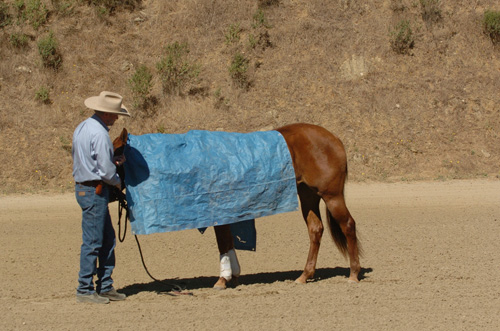 I started using a tarp in my training about fifteen to twenty years ago. Since then, the work with a tarp has evolved into a variety of exercises. Ten or fifteen years ago when I was working with a tarp at horse expositions, I was known as the “blue tarp guy” as few clinicians were using this tool. I still am the blue tarp guy as I have discovered the tarp is a great training tool. The tarp has become a standard piece of training equipment here at the barn.
I started using a tarp in my training about fifteen to twenty years ago. Since then, the work with a tarp has evolved into a variety of exercises. Ten or fifteen years ago when I was working with a tarp at horse expositions, I was known as the “blue tarp guy” as few clinicians were using this tool. I still am the blue tarp guy as I have discovered the tarp is a great training tool. The tarp has become a standard piece of training equipment here at the barn.
I use a tarp to get horses accustomed to having strange objects around their legs and backs. These are vulnerable places on a horse and good to desensitize. I use an eight by ten-foot tarp folded into a rectangle the size of a saddle blanket. I start by placing the tarp over the back of the horse. This is similar to sacking out using a saddle blanket except a tarp is more intense because it is stiff and crackles. Once a horse is accustomed to this, I open the tarp, covering a larger area of the horse’s back. I continue to do this until the full length and width of the tarp is totally draped over the horse.
One day in the round pen, I had a rope attached to the halter of a horse. I had the horse dragging the rope to get him used to ropes dragging around his feet. There was a tarp on the ground and the rope snagged in it. Then suddenly, the wind caught the tarp and blew it toward the rear feet of the horse. This really startled the horse and put him into the flight mode. I stopped the horse and worked him through the experience until he was calm. From this situation I realized the value in teaching a horse to drag a tarp. The crackling tarp represents a noise in the brush which can startle even a seasoned trail horse. I now have this as part of my basic foundation training program and I also use this exercise in my trail clinics.
Sometime later and on another horse, I was going down a hill when the cinch loosened and the saddle rolled off to the side. I could not free my foot from the stirrup. I ended up by the horse’s left rear foot which is not a good place to be. Thank heaven the horse was pretty well trained and had been sacked out as this could have been a bad wreck. From this situation, I realized the value of teaching a horse to drag a tarp near the back legs. I do this exercise in the round pen. The walls provide more control of the off side. I fasten a rope to the tarp and make sure the rope is loose enough to have a large drape so that the tarp drags near the rear feet of the horse. I do this until the horse is comfortable with tarp dragging along and bumping into his feet and legs.
Another way we use the tarp is to accustom a horse to banners and flags. Some of our riders do flag runs for various events and the horses need to be used to material flapping in the wind. If you have ever seen a horse jump when a flag or banner flaps in the wind, you will understand how valuable this exercise is. From the top of a fence we flap the tarp. The tarp is a scary object at first and but horses become used to it.
 To get a horse accustomed to going over scary objects like a fallen tree or a creek, I have an exercise that uses a tarp folded long and narrow. I lunge the horse near the object and finally over it. When a horse is comfortable with this on the ground, I do the same exercise mounted. I find that having done the ground work, the horse is usually willing to go over the object. Ideally the horse should be willing to cross the tarp no matter the width and to stop and stand on it. This is also the technique I use for teaching a horse to trailer load. A trailer is a big scary object that we are asking the horse to go into. Once a horse is comfortable with crossing a tarp on the ground, going into a trailer is not usually a big deal.
To get a horse accustomed to going over scary objects like a fallen tree or a creek, I have an exercise that uses a tarp folded long and narrow. I lunge the horse near the object and finally over it. When a horse is comfortable with this on the ground, I do the same exercise mounted. I find that having done the ground work, the horse is usually willing to go over the object. Ideally the horse should be willing to cross the tarp no matter the width and to stop and stand on it. This is also the technique I use for teaching a horse to trailer load. A trailer is a big scary object that we are asking the horse to go into. Once a horse is comfortable with crossing a tarp on the ground, going into a trailer is not usually a big deal.
Whether you are working to de-spook a trail horse, teaching a horse to trailer load or getting a show horse accustomed to the activities in an arena, a tarp is an excellent training tool. It is versatile and inexpensive.
Use a tarp to get your horse accustomed to having an object:
Around the feet and legs.
On and over the back.
Dragging behind.
Flapping in the wind.
Crackling and moving under foot.




